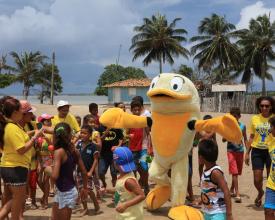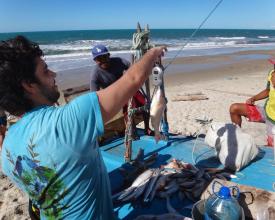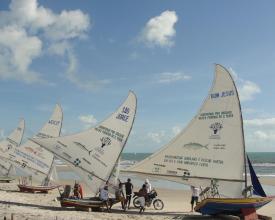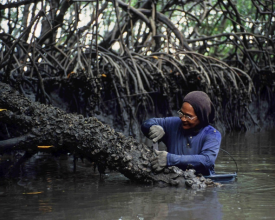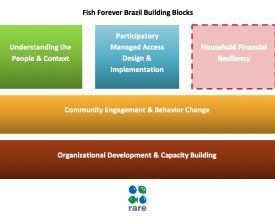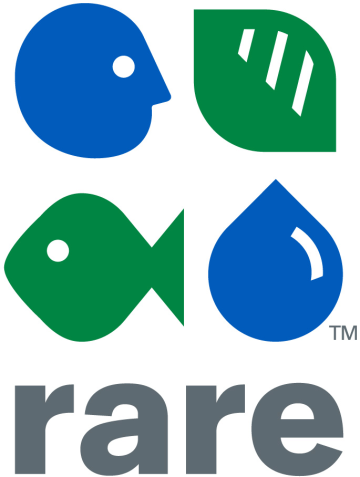
Fish Forever in Brazil: Solution for community-based fisheries management
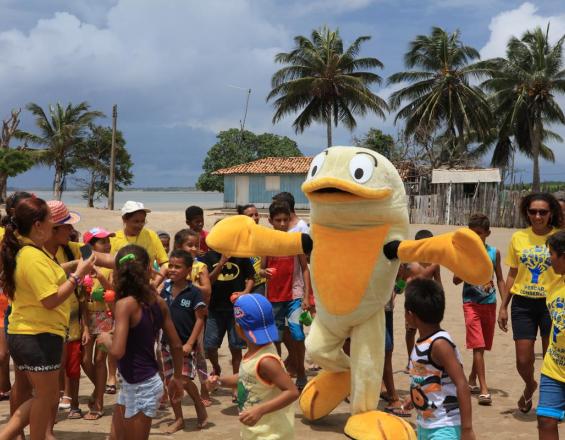
As coastal development increases in Brazil, artisanal fishers struggle to protect their resources. By leveraging the government-created Extractive Reserves' (RESEXs) legal structure and working with government, local fishers' organizations, and communities, Rare's Fish Forever program in Brazil has 1) established community-led governance and authority over artisanal fisheries; 2) designated managed-access fishing areas, combined with no-take reserves; and 3) improved participation of fishers and communitiy members in fisheries management and decision-making.
Context
Challenges addressed
Fish Forever’s first implementation in Brazil needed to overcome political disturbances that deeply impacted fisheries management at all scales. Fishers increasingly felt insecure, frustrated, and distrustful of government systems like RESEX. Communities are aware of overfishing of fish stocks and of the decline in fish size and quality, but are suspicious of new campaigns, based on their past experience of ineffective projects. Furthermore, leadership and organizational changes are frequent for RESEX management in the Brazilian government, which leads to frequent restarts of the project management process. Finally, the term “no-take zone” has a negative connotation for many artisanal fishers, which is why the term was changed to "Conservation and Reproduction Target-species Area" (ACRES), which also encompasses restoration of fish stocks through a national movement toward sustainable fishing practices, facilitating information sharing and awareness raising of fishers.
Location
Process
Summary of the process
The process goes through several stages, including "Understanding the People and Context", "Participatory Design Process and Implementation", "Community Engagement & Behavior Change", and "Organizational Development and Capacity-building". Fish Forever in other regions, like the Philippines, has also integrated schemes for building financial resileincy at the household level; an aspect which might be inlcuded in the Brazilian design at a later stage. All of the building blocks are underpinned throughout the entire project implementation by the building blocks of "Community Engagement and Behavior Change" and "Organizational Development and Capacity-Building". These two critical building blocks must accompany all the steps in the process in order to make them effective and long-lasting.
See graphic
Building Blocks
Understanding People and Context
Qualitative and quantitative research is conducted to produce profiles of both the fisheries and the fishers. Final decision for implementation sites and institutional partners for Brazil's first cohort were based on:
1) site fit (suitable ecological, fisheries, and social dynamics);
2) potential for strengthening the implementation of TURFs (=Territorial Use Rights for Fishing) and creation and implementation of no-take zones;
3) regional experience and lessons learned;
4) funding opportunities;
5) government (ICMBio) and partner priorities as opportunity for scaling; and,
6) analysis of potential threats to developing a TURF-Reserve (such as upstream dams, pollution, etc.).
This process is also instrumental to develop partnerships with local associations and leadership to approve the implementation of the campaigns in all sites.
Enabling factors
The Brazil RESEX (=extractive coastal and marine reserves) framework offers a favorable set-up to implement TURF-Reserves. While there are differences in governance between local communities’ approach and that of the National Government (ICMBio), we believe there is a great opportunity for collaborating in improving the management of MPAs in Brazil. Additional policy work and advocacy are crucially needed as part of Brazil's country strategy in order to secure fisheries access rights.
Lesson learned
- Fish Forever sites are carefully selected for potential impact. We learned from site selection that each site has a set of conditions that can enable success. We incorporated this lesson learned into the cohort selection process. Furthermore, some less-than-ideal sites will allow us to learn how to work across a wider range of sites.
- The chance to manage and ‘own’ their fisheries is a powerful benefit for fihsers, but biophysical and economic returns will also need to be estimated in order to motivate further communities.
- Related to the theme and the cohort objectives, a Pride+ strategy would be applied as the behavior change intervention strategy. Pride will address the expanded need beyond a social marketing approach, to also include other techniques, such as community mobilization, group-dynamic strategy, early on in order to create an enabling environment for the TURFs.
Participatory Managed Access Design & Implementation
Using the data from profiling, fishers and community leaders are engaged over a series of workshops that guide them through a) defining their community goals in relation to fisheries and conservation, b) evaluating their reserves, c) delineating areas for managed access, and d) agreeing on the rules within their managed access areas. Once these have been agreed on, they are codified in policy, and institutional arrangements are put into place for implementation.
Through behavior change campaigns, Fish Forever is increasing the productivity of management bodies. These bodies are then planning and approving new laws and roles for fisheries that will positively impact the community.
Enabling factors
The buy-in of the Brazilian government through RESEX management bodies and a pre-existing legal structure for managed access for fishers, paved the way for the campaign and managed access + reserve implementation.
Lesson learned
Inputs from the first stage on were critical to build trust. It is important that all discussions and agreements during the workshops are shared with communities and consultation sessions are held, before proceeding to the next stage of the design process.
Community Engagement & Behavior Change
The behaviour change campaign team at each municipality uses a mix of creative materials and community mobilization activities to inspire and educate fishers and their families about the benefits of working together to manage their fisheries better. In the ‘Readiness’ phase, the messages are focused on getting fishers to become registered fishers, complying with basic fishing laws, and participate in meetings. In the second phase, after the managed access areas are institutionalized, the messages focus on building compliance for the rules and monitoring of their catch. Through social marketing, Fish Forever can more easily earn buy-in from communities to follow best practices for fishing and encourage new solution innovations from communities for sustainable fisheries management.
Enabling factors
A strong sense of place and identity among fishers in communities and active support of municipal and village leaders, combined with motivated and efficient Fish Forever and Rare staff, has enabled sites in Brazil to replicated their success in other regions.
Lesson learned
Many commonalities exist between sites, so campaigns were able to use and adapt materials from other municipalities also focusing on fisheries management. Local adaptation, especially of mobilization activities, helped to make the campaigns more site-specific and ‘ownable’ by the community.
Organizational Development and Capacity-building
There are several critical organizations within communities that need to be developed or strengthened in order to ensure long-term success of the fisheries management. Campaigns must ensure that the fishery councils, the management bodies, and the fisher associations are organized and well-functioning. They are trained on topics like adaptive fisheries management, management essentials, volunteer management, and team building.
Enabling factors
To implement a shared management system, each RESEX has its own deliberative council, a management body of community-elected members, representing and voting on behalf of the community. Rare works directly with this group to improve the decision-making process at a community level. Rare’s local implementation partners are small associations with strong connections to the community. They are able to effectively manage funds and participate directly in the campaign project designs.
Lesson learned
Engaging the management body in definng the campaigns' goals, was a key milestone for Fish Forever campaigns. When these groups understood and supported Rare’s strategies, they were more willing to support the implementation of no-take zones and other sustainable fisheries management practices, like ACRES. Campaigns and capacity-building trainings also empowered these groups to share knowledge and positive experiences to other MPAs and management bodies in Brazil, through national fisheries organizations, who also supported in the replication and scaling of the next Fish Forever cohort.
Impacts
Fish Forever Brazil engaged 11 communities with 9,800 community members, committed to community-led sustainable fishery management.
357,096,000 ha of RESEX area across different sites are covered by this project. 14 no-take reserves were established, adding 1,383 ha protected by the local community (Table 1).
Behavior change campaigns promoted sustainable fisheries behavior at the site level (Table 2) and increased knowledge, interpersonal communication, and behavior change toward sustainable fishing practices, also at the national level. The campaigns encourage communities to participate directly in fisheries management and planning, contribute to scientific monitoring, and to create new regulations at the local level (Table 3).
Nine target-species with environmental, social and economic importance are now managed sustainably by communities, following best harvest and management practices. For the first time, 620 fishers (32% of target-fishers) are organized & use logbooks to record catches, allowing them to connect their catch to daily living expenses. Logbooks were implemented to comply with the RESEX fishery data-reporting requirements, and are accepted at many economic instituions as proof of income.
The community-based approach to developing governance, planning, and decision-making capacity provides benefits by enhancing adaptive capacity in the face of climate change.
Beneficiaries
- Fishers
- Fisher associations
- Brazilian Enviornmental Agenya (ICMBio)
- Local governments
- Women’s groups
- Researchers
Sustainable Development Goals
Story

In Brazil's Marine RESEX of Baia do Iguape in the state of Bahia,
women from the community work in the mangroves, farming and harvesting shellfish, incl. oysters. The women, most of whom are heads of single-parent households, go into the mangroves every day for this backbreaking work.
Oysters are a ecologically important species. They decrease pressure on the natural environment, and are an indicator species for the effectiveness of environmental protection initiatives. They are also of economic importantance because, as a fast-growing species, they provide more market potential for harvesters. However, unsustainable practices threaten the oysters' natural habitat, and the livelihoods of the people who harvest them.
In March 2016, Rare launched a pride campaign, led by Daniel Andrade. He is a leader in the community, as his grandparents were fishermen and used the RESEX area in the past for fishing. Daniel grew up going to the mangrove with his family, but continued in University and received a business degree. He now invests his knowledge and education as an adult to build community support for sustainably managing oysters. His pride campaign's launch event featured 30 women, who harvest oysters and other shellfish wearing campaign t-shirts. During the ceremony, one of the local leaders gave an emotional testimony about how, in the past, these women were ashamed of who they were—poor, always dirty from the mangrove mud. This project has helped raise their self-esteem and instill a sense of pride in these women for their work and identity. Now they wear the mud as a badge of honor.
The campaign promoted sustainable cultivation practices and worked to install oyster family farms to decrease fishing pressure on oyster populations in the mangroves. Daniel was also able to raise funds from the state government for equipment and a new headquarter building. He and the women leaders met with neighbouring communities to find out how to connect to supply chains in order to bring oysters to the market.
From a social standpoint, the campaign has had an impact by empowering women and building community pride. By improving work skills and the conditions for oyster cultivating and building access to markets, the campaign will boost the livelihoods of these women and their families.
